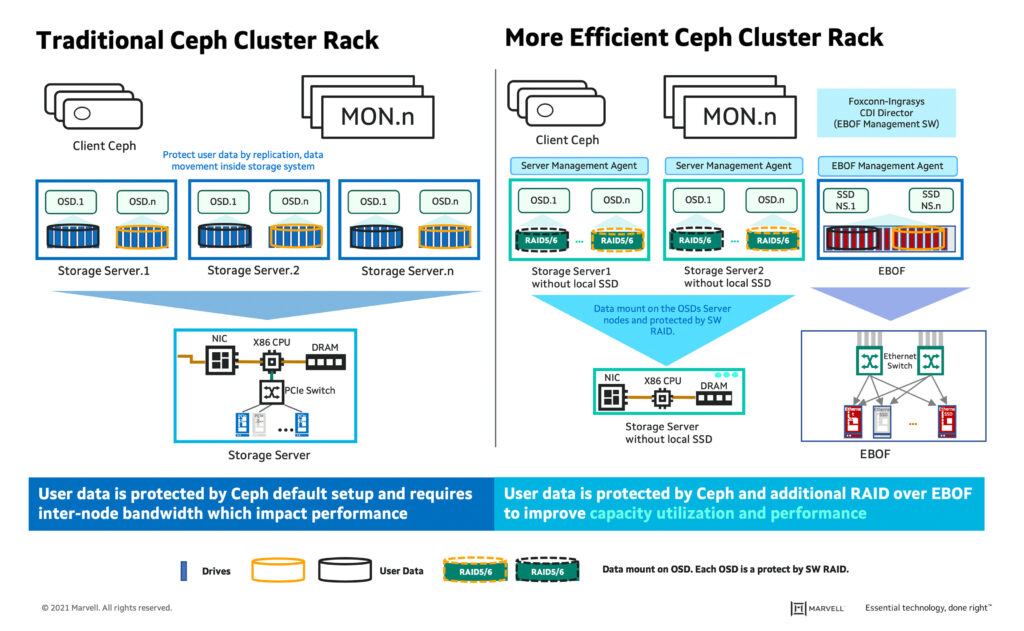- 製品
- 会社概要
- サポート
- 製品
- タイプ別
- 市場別
コンピューティング
ネットワーキング
ストレージ
カスタム
- 会社概要
Posts Tagged 'HPC'
-
マーベルとIngrasys、データセンターのEBOFでCephクラスタを強化するために協業
By Khurram Malik, Senior Manager, Technical Marketing, Marvell
A massive amount of data is being generated at the edge, data center and in the cloud, driving scale out Software-Defined Storage (SDS) which, in turn, is enabling the industry to modernize data centers for large scale deployments. Ceph is an open-source, distributed object storage and massively scalable SDS platform, contributed to by a wide range of major high-performance computing (HPC) and storage vendors. Ceph BlueStore back-end storage removes the Ceph cluster performance bottleneck, allowing users to store objects directly on raw block devices and bypass the file system layer, which is specifically critical in boosting the adoption of NVMe SSDs in the Ceph cluster. Ceph cluster with EBOF provides a scalable, high-performance and cost-optimized solution and is a perfect use case for many HPC applications. Traditional data storage technology leverages special-purpose compute, networking, and storage hardware to optimize performance and requires proprietary software for management and administration. As a result, IT organizations neither scale-out nor make it feasible to deploy petabyte or exabyte data storage from a CAPEX and OPEX perspective.
Ingrasys (subsidiary of Foxconn) is collaborating with Marvell to introduce an Ethernet Bunch of Flash (EBOF) storage solution which truly enables scale-out architecture for data center deployments. EBOF architecture disaggregates storage from compute and provides limitless scalability, better utilization of NVMe SSDs, and deploys single-ported NVMe SSDs in a high-availability configuration on an enclosure level with no single point of failure.
Ceph is deployed on commodity hardware and built on multi-petabyte storage clusters. It is highly flexible due to its distributed nature. EBOF use in a Ceph cluster enables added storage capacity to scale up and scale out at an optimized cost and facilitates high-bandwidth utilization of SSDs. A typical rack-level Ceph solution includes a networking switch for client, and cluster connectivity; a minimum of 3 monitor nodes per cluster for high availability and resiliency; and Object Storage Daemon (OSD) host for data storage, replication, and data recovery operations. Traditionally, Ceph recommends 3 replicas at a minimum to distribute copies of the data and assure that the copies are stored on different storage nodes for replication, but this results in lower usable capacity and consumes higher bandwidth. Another challenge is that data redundancy and replication are compute-intensive and add significant latency. To overcome all these challenges, Ingrasys has introduced a more efficient Ceph cluster rack developed with management software – Ingrasys Composable Disaggregate Infrastructure (CDI) Director.
最新の記事
- HashiCorp and Marvell: Teaming Up for Multi-Cloud Security Management
- Cryptomathic and Marvell: Enhancing Crypto Agility for the Cloud
- The Big, Hidden Problem with Encryption and How to Solve It
- Self-Destructing Encryption Keys and Static and Dynamic Entropy in One Chip
- Dual Use IP: Shortening Government Development Cycles from Two Years to Six Months
アーカイブス
カテゴリ
- 5G (12)
- AI (11)
- 車載機器 (26)
- クラウド (7)
- コヒーレントDSP (2)
- 企業ニュース(100)
- カスタムシリコンソリューション (1)
- データセンター (39)
- データ処理ユニット (22)
- エンタープライズ (25)
- ESG (6)
- イーサネット・アダプター、コントローラー (12)
- イーサネット PHY (4)
- イーサネットスイッチ (30)
- ファイバーチャネル (10)
- Marvell Government Solutions (2)
- ネットワーク (31)
- Optical Modules (9)
- セキュリティ (3)
- Server Connectivity (15)
- SSD コントローラ (6)
- ストレージ (22)
- ストレージの推進者 (2)
- What Makes Marvell (19)
- Coherent DSP (3)
- 企業ニュース(3)
- Optical Module (3)
- PAM4 DSP (3)
- セキュリティ (3)
会社情報
リクルーティング情報
表示言語 (Language)
Copyright © 2024 Marvell, All Rights Reserved
- 利用規約
- プライバシーポリシー
- お問い合わせ先

